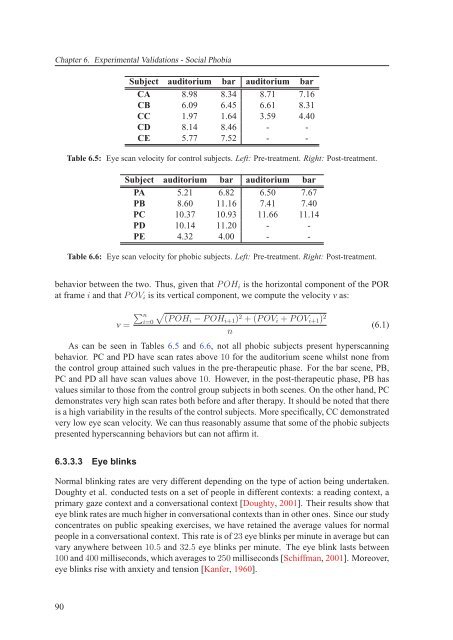Texte intégral / Full text (pdf, 20 MiB) - Infoscience - EPFL
Texte intégral / Full text (pdf, 20 MiB) - Infoscience - EPFL
Texte intégral / Full text (pdf, 20 MiB) - Infoscience - EPFL
Create successful ePaper yourself
Turn your PDF publications into a flip-book with our unique Google optimized e-Paper software.
Chapter 6. Experimental Validations - Social Phobia<br />
Subject auditorium bar auditorium bar<br />
CA 8.98 8.34 8.71 7.16<br />
CB 6.09 6.45 6.61 8.31<br />
CC 1.97 1.64 3.59 4.40<br />
CD 8.14 8.46 - -<br />
CE 5.77 7.52 - -<br />
Table 6.5: Eye scan velocity for control subjects. Left: Pre-treatment. Right: Post-treatment.<br />
Subject auditorium bar auditorium bar<br />
PA 5.21 6.82 6.50 7.67<br />
PB 8.60 11.16 7.41 7.40<br />
PC 10.37 10.93 11.66 11.14<br />
PD 10.14 11.<strong>20</strong> - -<br />
PE 4.32 4.00 - -<br />
Table 6.6: Eye scan velocity for phobic subjects. Left: Pre-treatment. Right: Post-treatment.<br />
behavior between the two. Thus, given that POHi is the horizontal component of the POR<br />
at frame i and that POVi is its vertical component, we compute the velocity v as:<br />
n<br />
i=0 (POHi − POHi+1)<br />
v =<br />
2 +(POVi + POVi+1) 2<br />
(6.1)<br />
n<br />
As can be seen in Tables 6.5 and 6.6, not all phobic subjects present hyperscanning<br />
behavior. PC and PD have scan rates above 10 for the auditorium scene whilst none from<br />
the control group attained such values in the pre-therapeutic phase. For the bar scene, PB,<br />
PC and PD all have scan values above 10. However, in the post-therapeutic phase, PB has<br />
values similar to those from the control group subjects in both scenes. On the other hand, PC<br />
demonstrates very high scan rates both before and after therapy. It should be noted that there<br />
is a high variability in the results of the control subjects. More specifically, CC demonstrated<br />
very low eye scan velocity. We can thus reasonably assume that some of the phobic subjects<br />
presented hyperscanning behaviors but can not affirm it.<br />
6.3.3.3 Eye blinks<br />
Normal blinking rates are very different depending on the type of action being undertaken.<br />
Doughty et al. conducted tests on a set of people in different con<strong>text</strong>s: a reading con<strong>text</strong>, a<br />
primary gaze con<strong>text</strong> and a conversational con<strong>text</strong> [Doughty, <strong>20</strong>01]. Their results show that<br />
eye blink rates are much higher in conversational con<strong>text</strong>s than in other ones. Since our study<br />
concentrates on public speaking exercises, we have retained the average values for normal<br />
people in a conversational con<strong>text</strong>. This rate is of 23 eye blinks per minute in average but can<br />
vary anywhere between 10.5 and 32.5 eye blinks per minute. The eye blink lasts between<br />
100 and 400 milliseconds, which averages to 250 milliseconds [Schiffman, <strong>20</strong>01]. Moreover,<br />
eye blinks rise with anxiety and tension [Kanfer, 1960].<br />
90

















